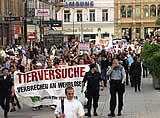KTRK-TV is the
ABC owned and operated station in
Houston, Texas. Its studio is located at 3310 Bissonnet Street in the
Upper Kirby district of central Houston (
ZIP code 77005), and its transmitter is located in
Missouri City.
The station grew out of the VHF "freeze", when three entities vying for the channel 13 assignment, including the
Houston Chronicle, decided to merge as
Houston Consolidated Television. They bought the studio facilities of the defunct KNUZ-TV (ch 39), a
DuMont UHF affiliate which had gone dark. The original studio facilities were located at 4513 Cullen Blvd (in the
University of Houston complex; this studio later housed KHTV [now
KHCW) and
KUHT.
Originally launched as KXYZ in 1954, the call letters were changed to KTRK in 1955 after the
Chronicle bought out its partners. The calls were derived from
KTRH, which the
Chronicle then owned. For many years, it called itself "The Houston Chronicle Station." Soon afterwards, the station moved to its current Bissonnet Street location. The studio was the first domed structure in town, preceding the better-known
Astrodome by 10 years. Both projects were built by the same architect,
Hermon Lloyd.
Like many stations located on "unlucky" channel 13, it used a
black cat as its mascot. For many years, the station ran a children's show featuring a black cat, "Kitirik", by adding an "I" between the station's call letters. She wore a cat suit complete with mink ears and tail, and drawn-on whiskers. Her real name was Bunny Orsak. She had two sons, Gary and Lane.
[1] Early programs involved a heavy emphasis on local flavor and reflected themes of the day. Some of the more popular local shows included:
Additionally, in its beginning stages, former
CBS Evening News anchor
Dan Rather got his start in television as a reporter for KTRK in 1959.
In
1967, the
Houston Chronicle sold KTRK to
Capital Cities Communications. Under CapCities' ownership, KTRK preempted some ABC programming, though not nearly as much as other ABC affiliates, such as sister station,
WPVI-TV in
Philadelphia. The shows KTRK preempted were not widely run in many markets, though for many years KTRK pre-empted the first half-hour of "
Good Morning America" in favor of a local newscast. This practice continued into the early-90s, before the newscast was moved back to a pre-7:00am start time. After 1991, its only preemption was half of "The Home Show." KTRK only ran the first half-hour, an arrangement which continued when the show morphed into
Mike and Maty. When "
The View" premiered in the time-slot, KTRK began running the entire show. Despite these preemptions, ABC was more than satisfied with KTRK, one of its strongest affiliates. CapCities bought ABC in 1986, making KTRK an ABC-owned and operated station. With that distinction, KTRK would become one of the two first network O&Os in Houston. That same year,
News Corporation's newly created
Fox Television Network purchased
KRIV-TV. Capital Cities/ABC was sold to Disney at the end of 1995.
Today, KTRK runs the entire ABC schedule, though there are times when local special events are aired in place of network programming. KTRK is also different from many ABC owned-and-operated stations in that it has never aired
The Oprah Winfrey Show, or the current syndicated versions of
Wheel of Fortune and
Jeopardy!, all of which have been mainstays on most of ABC's owned-and-operated stations for years. In fact, at one point during the late 80s to early 90s,
The Phil Donahue Show was the only daytime syndicated program on KTRK's lineup. This was largely due to its hour-long 6 p.m. newscast as well as its popular movie showcases and local programming at the time, including
Good Morning Houston. For many years, KTRK was also the original television home of the
Houston Astros, however it only televised Sunday afternoon road games. Today, KTRK broadcasts only three syndicated programs during weekdays:
Live with Regis and Kelly, the syndicated version of
Who Wants to Be a Millionaire, and
Inside Edition.
KTRK has been the official television home of the
Houston Texans since their expansion year in 2002. The station has televised all of the Texans' preseason games not carried on national networks since the team's inception. On Sundays during the Texans' season, it televises a post-game show,
Houston Texans Inside the Game at 10:35 p.m. following its Sunday newscast. On Mondays during the regular season, it televises
Look Back with Kubiak, in which sports director Bob Allen looks over the previous Sunday's game with Texans head coach
Gary Kubiak, during its 6 p.m. newscasts. On Saturdays, its
Extra Points sports show is converted to a special edition entitled
Extra Points: Houston Texans Edition at 6:30 PM.
The station's newscast,
Eyewitness News, has been number one in the Houston market for most of the last 30 years. It is also one of the highest-rated newscasts in the country. In recent years, however, KTRK has faced strong challenges from rival CBS affiliate
KHOU-TV, often battling with KHOU for number one during its evening newscasts. In 2005, KHOU overtook KTRK during evening newscasts and at one time ousted KTRK's longtime No. 1 position in the mornings. KTRK-TV recently took the lead again in the mornings, as well as at midday, and 5 p.m.
The rivalry is so intense that KTRK has even gone as far as advertising its newscasts as the most watched in Houston in terms of total households for all of its newscasts. KTRK-TV has always led in household ratings, something it continues to do. It broadcasts more hours of local news than any other Houston television station with six hours on weekdays, two and a half hours on Saturday and four hours on Sunday.
On August 12, channel 13 debuted in HD. Becoming the second in Houston to do so behind channel 11 (KHOU). Many Houston columnists and bloggers belive that channel 13 (KTRK) will take the lead once again as Houstons News Leader. That will be determined when ratings come out in September.

KTRK is widely noted for having the most experienced news team in
Greater Houston, the tenth-largest media market in the
United States as of 2006-07. Many of the station's anchors and reporters have been at the station for at least 20 years, some even dating back to the station's days under Capital Cities ownership.
Dave Ward has been the station's main anchor since
1968, longer than anyone in Houston television history. Two other notable long-time personalities are sports director Bob Allen, who has served in that position since 1974, longer than any other major-market sports director, and investigative reporter
Wayne Dolcefino, who has worked for KTRK since 1985 and has won many awards for a number of high-profile civic and consumer investigations with his
13 Undercover franchise.
KTRK also became known for its legendary consumer and investigative reporter,
Marvin Zindler, whose week-long 1973 reports on a brothel in
La Grange, Texas led to the closing of the
Chicken Ranch, a bordello that was later immortalized in the musical and film,
The Best Little Whorehouse in Texas and
ZZ Top's hit song
La Grange. Zindler was also widely noted in Houston for his Friday night
Rat and Roach Report on Houston restaurants that failed health inspections, which ended with his trademark line "Slime in the Ice Machine". Zindler signed a lifetime contract with KTRK in 1988, making him the first person ever offered such a contract by then-owner Capital Cities, which was known as a financially frugal company. Zindler continued to work for the station until his death in 2007 from pancreatic cancer, even filing reports during his treatment.
In the 1970s and 1980s, Ward, along with Allen, Zindler, and weatherman Ed Brandon, led Houston's top-rated news team at 6 p.m. and 10 p.m. The lineup was later revised to include a female anchor, Shara Fryer in the 1990s, followed by current chief meteorologist Tim Heller in lieu of Brandon at 10 p.m. in 2002, and the replacement of Fryer with Gina Gaston the following year. In 2007, Brandon retired from the station after a 35-year career, but has occasionally filled in.
KTRK's "Circle 13" logo is the same as that for KTRK's
Toledo sister station,
WTVG, only that KTRK calls itself "ABC 13", while WTVG is known as "13 ABC".
Its previous logo, which ran from 1971 until the mid 1990s, was a "Crooked Circle 13." It recalled
livestock branding of the
Old West and was set in
Helvetica font, with the bottom of the "3" trailing off out of the circle.
For many years since the mid-1990s, both logos have been superimposed on an image of the Texas state flag.
Today, KTRK uses 2 different logos. One is the logo shown above, and they have 2 other variations of that they also use. The other is the number 13 in a circle shown at an angle. This is only used during newscasts.
Circle 7 logo (The Circle 13 is the derivative of the Circle 7.)
KTRK's old callsign KXYZ was, by coincidence, a western reflection of today's ABC affiliate
WXYZ in Detroit based on the last few letters of the alphabet.
KPRC 2 (NBC, WX+ on DT2, LATV on DT3) - KUHT 8 (PBS, PBS-X on DT2, V-me on DT3) - KHOU 11 (CBS, HD Doppler on DT2) - KTRK 13 (ABC, news on DT2, AccuWX TV on DT3) - KETH 14 (TBN, The Church Channel on DT2, JCTV on DT3, TBN Enlace on DT4, Smile of a Child on DT5) - KTXH 20 (MNTV) - KVQT 21 (Span. Rel.) - KLTJ 22 (DS) - KRIV 26 (Fox) - KCVH 30 (LAT TV) - KUVM 34 (AZA) - KHCW 39 (The CW, The Tube on DT2) - KHLM 43 (Multimedios) - KXLN 45 (UNI) - KTMD 47 (TEL) - KPXB 49 / KBPX 33 (ION, qubo on DT2, ION Life on DT3) - KNWS 51 (Ind) - KTBU 55 (A1) - KAZH 57 / KHMV 28 / KVVV 53 (TuV) - KZJL 61 (Ind) - KFTH 67 (TFU) KVVV 16 (Ind) KMID 2 (Midland) - KIII 3 (Corpus Christi) - KRGV 5 (Weslaco) - KLTV 7 / KTRE 9 (Tyler / Lufkin) - KVIA 7 (El Paso) - KVII 7 (Amarillo) - WFAA 8 (Dallas) - KBMT 12 (Beaumont) - KSAT 12 (San Antonio) - KTXS 12 / KTXE 38 (Sweetwater / San Angelo) - KTRK 13 (Houston) - KVUE 24 (Austin) - KAVU 25 (Victoria) - KXXV 25 / KRHD 40 (Waco / Bryan) - KAMC 28 (Lubbock) Coordinates: 29°34′28″N, 95°29′38″W Cadet Don: A Space-themed adventure program for children, focusing on the exploits of an interstellar adventurer and the locations he visited.
Dialing for Dollars: A game show of sorts where a viewer would be phoned by the host and would win a cash prize by answering questions.
Good Morning Houston: The successor to Dialing for Dollars which debuted in the late 1970s and expanded to include discussions on local events and topics important to viewer's lifestyles.
Tom Abrahams: Weekend Evening Anchor
Ilona Carson: 4PM Anchor
Mark Garay: Weekend Morning Anchor
Elissa Rivas: Weekend Morning Anchor
Gina Gaston: 6PM and 10PM
Stephanie Guadian: Weekend Evening Anchor
Tom Koch: Weekday Morning and 4PM Anchor
Melanie Lawson: 11AM and 5PM Anchor
Sharron Melton: Weekday Morning Anchor
Art Rascon: 5PM Anchor
Dave Ward: 6PM and 10PM Anchor (ABC13's main anchor since 1968)
Gene Apodaca: General Assignment Reporter
Craig Bell: General Assignment Reporter
Andy Cerota: General Assignment Reporter
Cynthia Cisneros: General Assignment Reporter
Katisha Cosley: General Assignment Reporter
Christine Dobbyn: General Assignment Reporter
Wayne Dolcefino: "13 Undercover" Investigative Reporter
Jeff Ehling: "Action 13" Consumer Reporter
Eric James: General Assignment Reporter
Christi Myers: "13 Healthcheck" Reporter
Don Nelson: Entertainment/Traffic Reporter
Ted Oberg: "In Focus" Reporter
Kevin Quinn: General Assignment Reporter
Elissa Rivas: General Assignment Reporter
Miya Shay: General Assignment Reporter
Laura Whitley: General Assignment Reporter
Jessica Willey: General Assignment Reporter
Deborah Wrigley: General Assignment Reporter
Richard Alderman: The People's Lawyer
Joel Androphy: Legal Analyst
Dr. Richard Murray: Political Analyst
Tim Heller: Chief Meteorologist, seen weekday evenings
Travis Herzog: 11am and 4pm Weather Anchor
Casey Curry: Weekday Morning Meteorologist
David Tillman: Weekend Evening Meteorologist
Doug Brown: Weekend Morning Meteorologist
Bob Allen: Sports Director (longest tenured sports director at any major-market station)
Tim Melton: Weekend Anchor
Bob Slovak: Sports Reporter
Chris Adams: reporter (1992-2004)
Carlos Aguilar reporter (1980-1995)
Dan Ammerman: reporter
Vicente Arenas: reporter (mid 1990s, currently weekend anchor with KHOU)
Elma Barrera: reporter (mid 1970s-2006, retired)
Jim Bergamo: reporter (now reporter at
KVUE in Austin)
Frank Billingsley: weekend meteorologist (1989-1995, currently chief meteorologist at KPRC)
Bob Boudreaux: anchored "Live at Five" before 1990, later weekend anchor (1977-2005)
Ed Brandon: weatherman (1972-2007, was chief weatherman until 2002, now retired)
Dan Cambre: reporter (1990s)
Jan Carson: 6 and 10 pm co-anchor (1975-1980, later left for San Francisco before returning to Houston on KPRC-TV in 1983, now retired but still well known in
Greater Houston)
Shern-Min Chow: reporter (1983-1991, now at KHOU)
Larry Conners: anchor/investigative reporter (1972-1975, now at
KMOV-TV in St. Louis)
Mary Ellen Conway: reporter
Chris Curle: reporter (mid 1970s)
John Nigel Davenport: (died in 1991)
Joe Diaz: weekend meteorologist (1989-1997; currently Chief Meteorologist at
KOAT in Albuquerque)
Thom Dickerson: reporter
Deborah Duncan: host, "The Deborah Duncan Show" (1998-2002, plans for ABC/Disney to pick it up fell through, now morning anchor at KHOU)
Troy Dungan: chief weatherman (196?-1974, later became legendary weathercaster for
WFAA-TV in
Dallas, now retired)
Lis Exon: police/investigative reporter (1990s, now news manager at
OETA (PBS Oklahoma) in Tulsa)
Diana Fallis: (ABC13's first African American female anchor - later served as a media relations liaison with Prairie View A & M University)
Shara Fryer: anchor/reporter (1980-2006)
Roland Galvan: meteorologist (1986-1988; later moved to
KTLA in Los Angeles, last at KIII in Corpus Christi, deceased)
Stephen Gauvain: NASA reporter (deceased; in 1996, a Ford Explorer SUV Gauvain rode in flipped over while his crew was returning from coverage of the Hilton Crawford murder trial in Huntsville, Texas. The cause of the accident, a
defective Firestone tire, would later lead to an investigation exposed by rival KHOU that led to numerous lawsuits and a complete recall of the tires.)
Bruce Gietzen: sports reporter (now evening anchor at
KXXV in Waco)
Jan Glenn: co-host of "Good Morning Houston" from 1977-1991 with Don Nelson, and was once married to sports anchor Bob Allen. Retired from KTRK and briefly worked with KHCW covering special events such as the
Houston Livestock Show and Rodeo.
David Glodt: anchor/reporter
Van Hackett: anchor/reporter (1980s)
Nydia Han: consumer reporter (currently at
WPVI in Philadelphia)
Kimberly Harms: sports reporter (1994-1998)
Charles Harrison: meteorologist/voice announcer (retired)
Alan Hemberger: "Live at Five" anchor (1989-1998, now at KHCW)
Corin Hoggard: sub-anchor/reporter (currently reporter at KFSN)
Cynthia Hunt: (Currently at Cynthia Hunt Productions and afternoons 2-4 at KPRC-AM "Chris Baker & Cynthia Hunt Show")
James Irby: reporter (2000-2004, now weekend anchor at KTBC in Austin)
Debbie Johnson: reporter
Heidi Jones: Midday and 4 PM meteorologist (1997-2004, now weekend meteorologist at
WABC-TV in New York)
Larry Kane: host, "The Larry Kane Show" (1959-1971, deceased)
Cheryle Keck: morning anchor (deceased)
Ed Kilgore: sports anchor/reporter (1971-1973, now at
WGRZ-TV in Buffalo)
Don Kobos: reporter (19??-2000, later became KTRK's assistant news director)
Dan Lovett: sports anchor (left in 1974 for WABC-TV in New York, has since returned to Houston)
Darren Lyn: reporter (2002-2006, later became a Houston-based reporter for sister network
ESPN)
Tim Malloy: anchor (1989-1994, now at
WPTV in West Palm Beach)
Jeff McShan: reporter (1992-1993, now at KHOU)
Doug Murphy: weekend sports anchor (moved to
KPIX-TV in San Francisco in 1982, deceased)
Patrick Nolan: reporter (2000-2003, now evening anchor at WFTX in Fort Myers, Florida)
Gene Norman: weekend meteorologist (now chief meteorologist at
WGCL-TV in Atlanta)
Bunny Orsak: (1954-1972), host of
The Kitirik Show. Orsak holds the honor of being the first woman on-screen for KTRK.
Minerva Perez: (1992-2007, left because of disagreement of morning newscasts)
Dan Rather: (1959-1961, eventually succeeded Walter Cronkite as anchor of CBS Evening News until his 2005 retirement)
Sylvan Rodriguez: (1977-1986, left for ABC News' West Coast bureau, later returning to Houston with KHOU-TV, deceased)
Jim Rosenfield: anchor (1983-1989, now at
WCBS-TV in New York)
Tim Ryan: reporter (1981-1983, now at
KDFW-TV in Dallas)
Lisa Trapani: co-host of
Good Morning Houston (1991-2000, now marketing director at KHOU)
Alvin Van Black: entertainment/nightlife reporter, particularly "Alvin at Night" segments during 10 p.m. newscasts on Friday nights (1987-1998, deceased)
Marvin Zindler: legendary "Action 13" consumer/investigative reporter, mainly during 6pm newscasts (1973-2007, deceased)
The Texas News (1962-1965)
Channel 13 News (1965-
January 1,
1973)
13 Eyewitness News (
January 1,
1973-present)
Houston's News Leader (1995-present)
KTRK-TV Query the FCC's TV station database for KTRK-TV
 The arguments
The arguments

 History
History Hubbell in popular culture
Hubbell in popular culture
 Publications
Publications

 The Gräfenberg spot, or G-spot, is a small area in
The Gräfenberg spot, or G-spot, is a small area in 

 Busia government
Busia government
 Project Cyborg
Project Cyborg Bibliography
Bibliography 2001
2001  Phonology
Phonology